
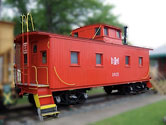




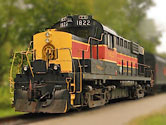
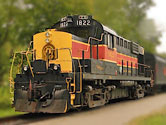
Museum




 |
Georgia State Railroad Museum"The most complete antebellum railroad location in the country" |

Savannah, Ga / Dec 2019 / RWH
The Historic Railroad Shops complex is among the finest remaining examples of Victorian railroad architecture and design and is the most intact antebellum railroad repair complex in the country. It was designated a National Historic Landmark by the National Park Service. On-site displays include antique shaft driven machinery, locomotives and railroad stock, model train layouts, an operating turntable, and the oldest portable steam engine in the United States. The Historic Railroad Shops offers a valuable educational experience for students and has also become a popular local tourist attraction.
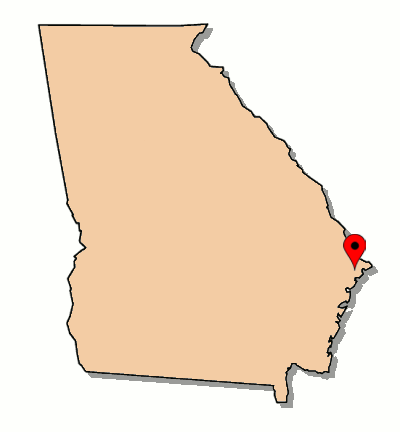
 he Georgia State Railroad Museum is located in downtown Savannah, Georgia, on the site of the former Central of Georgia Railway heavy shops and terminal facilities. After the Southern Railway absorbed the Central in 1963, the site was transferred to the City of Savannah. Formerly known as the Roundhouse Railroad Museum, the site was declared a National Historic Landmark in 1976 and by 1989 was developed into a railroad museum by the non-profit Coastal Heritage Society in cooperation with Savannah. Together with the adjacent former Central of Georgia station and train shed, the entire area is designated as a Historic Landmark District. The railroad structures at the museum site include a partial roundhouse with operating 85' turntable, partial machine shop, tender frame shop, blacksmith shop, boiler house, storehouse and print shop, lumber and planning sheds, coach and paint shops, and a partial carpentry shop which now houses the Savannah Childrens Museum. The museum maintains a collection of former Central of Georgia locomotives and rolling stock, as well as equipment from other railroads with ties to the coastal Georgia region. Operating steam and diesel motive power, restored and maintained onsite, are used to tranport visitors on a short ride across the grounds.
he Georgia State Railroad Museum is located in downtown Savannah, Georgia, on the site of the former Central of Georgia Railway heavy shops and terminal facilities. After the Southern Railway absorbed the Central in 1963, the site was transferred to the City of Savannah. Formerly known as the Roundhouse Railroad Museum, the site was declared a National Historic Landmark in 1976 and by 1989 was developed into a railroad museum by the non-profit Coastal Heritage Society in cooperation with Savannah. Together with the adjacent former Central of Georgia station and train shed, the entire area is designated as a Historic Landmark District. The railroad structures at the museum site include a partial roundhouse with operating 85' turntable, partial machine shop, tender frame shop, blacksmith shop, boiler house, storehouse and print shop, lumber and planning sheds, coach and paint shops, and a partial carpentry shop which now houses the Savannah Childrens Museum. The museum maintains a collection of former Central of Georgia locomotives and rolling stock, as well as equipment from other railroads with ties to the coastal Georgia region. Operating steam and diesel motive power, restored and maintained onsite, are used to tranport visitors on a short ride across the grounds.

Click to see the museum grounds plotted on a Google Maps page
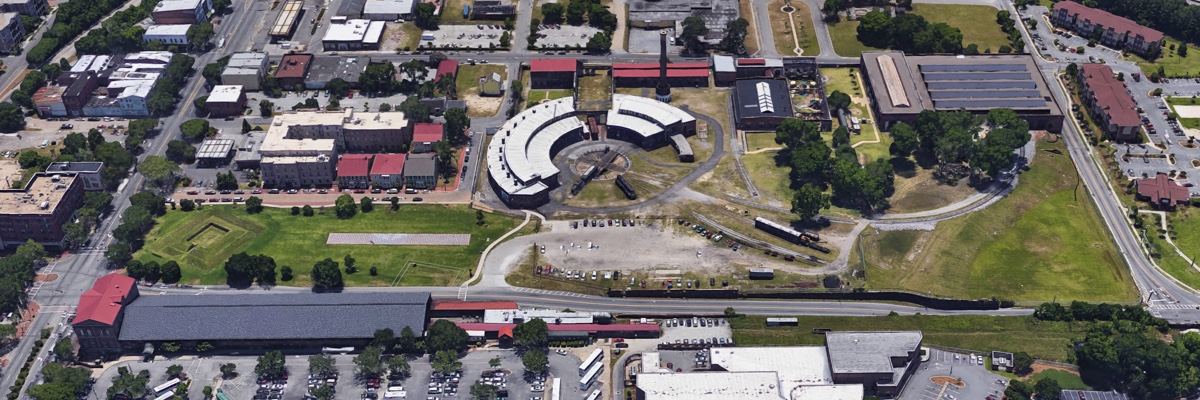
museum overhead / Google Maps
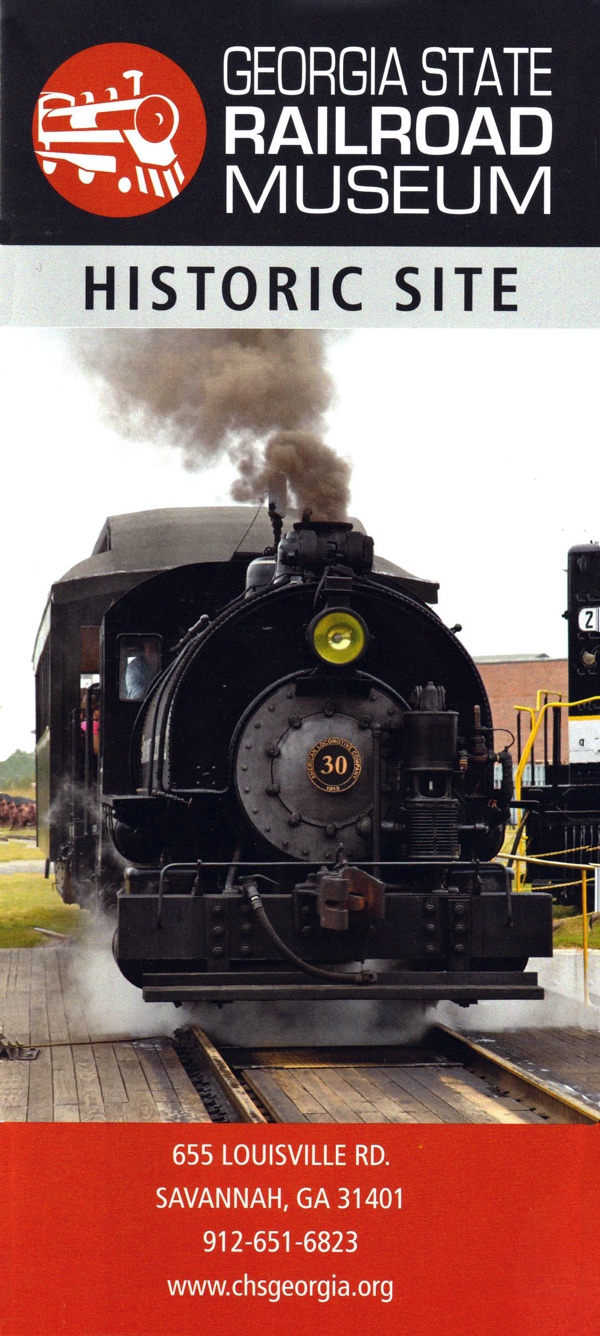
2019 brochure / collection
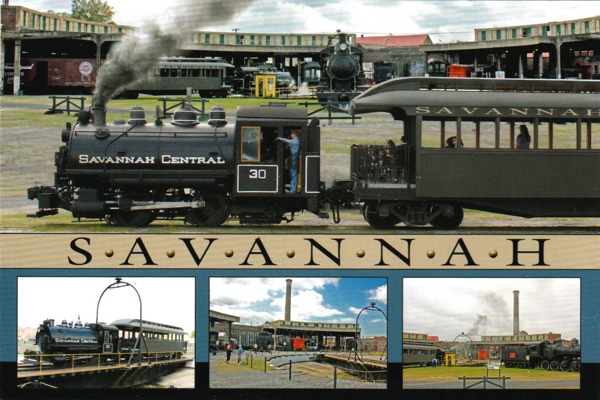
postcard / collection
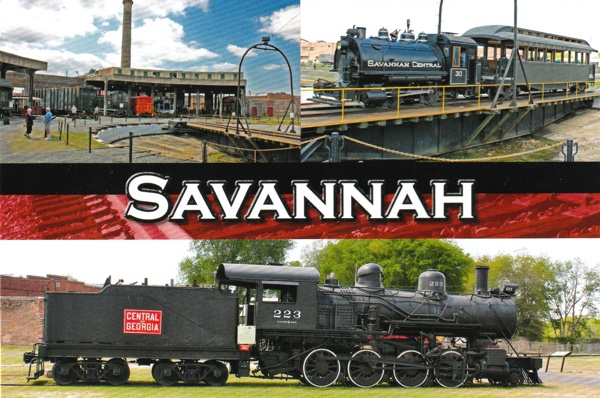
postcard / collection


1910 Official Guide map / collection
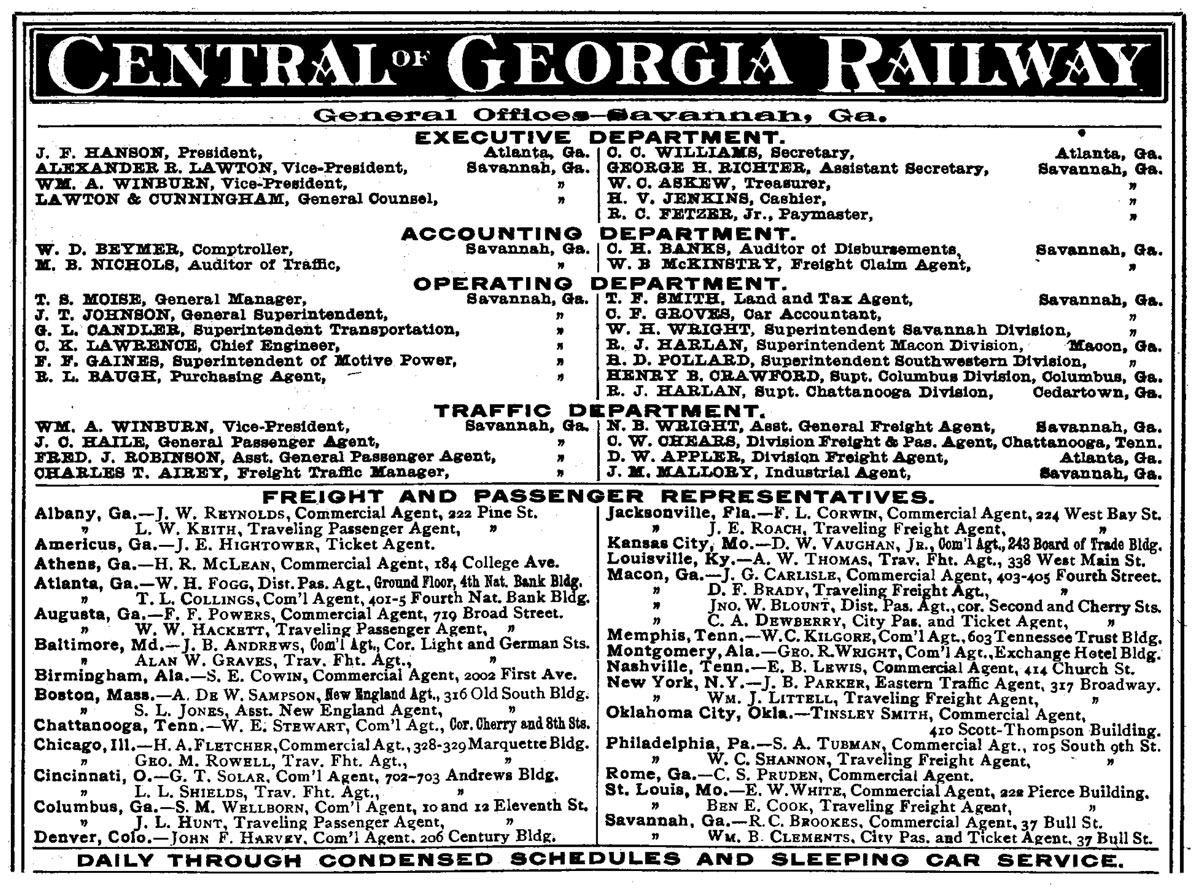
1910 Official Guide ad / collection

Dec 2019 / RWH

Dec 2019 / RWH

Savannah, Ga / Oct 2024 / RWH
Scrapbooks
Publications

collection
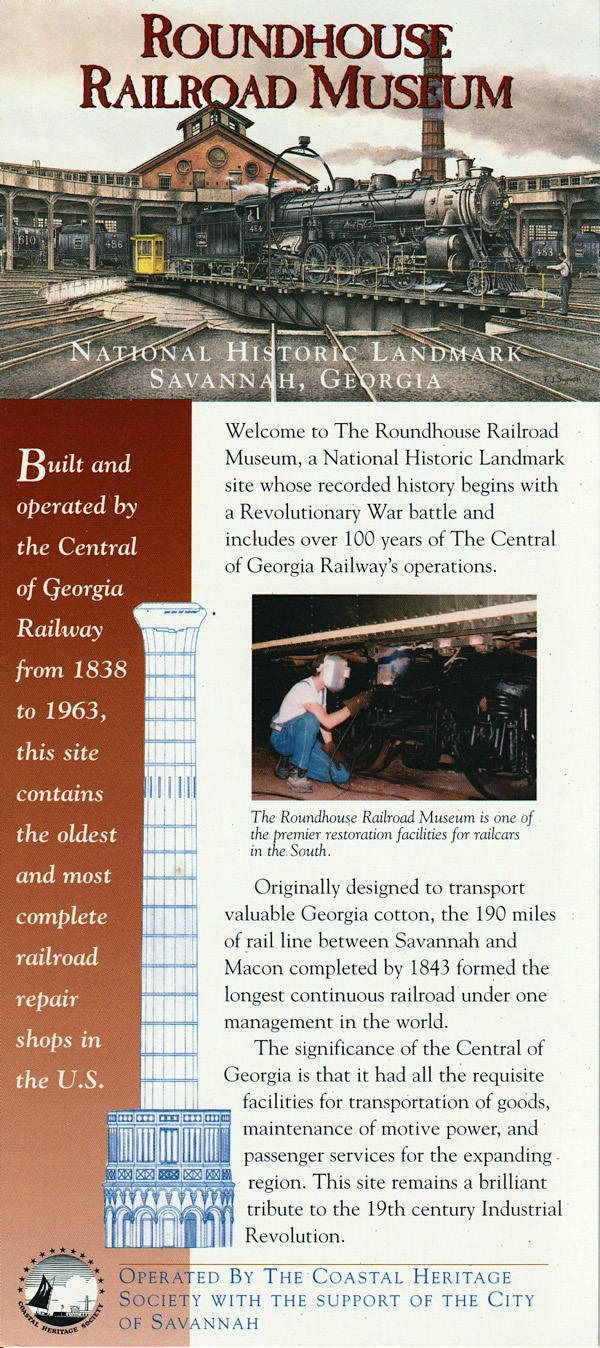
collection
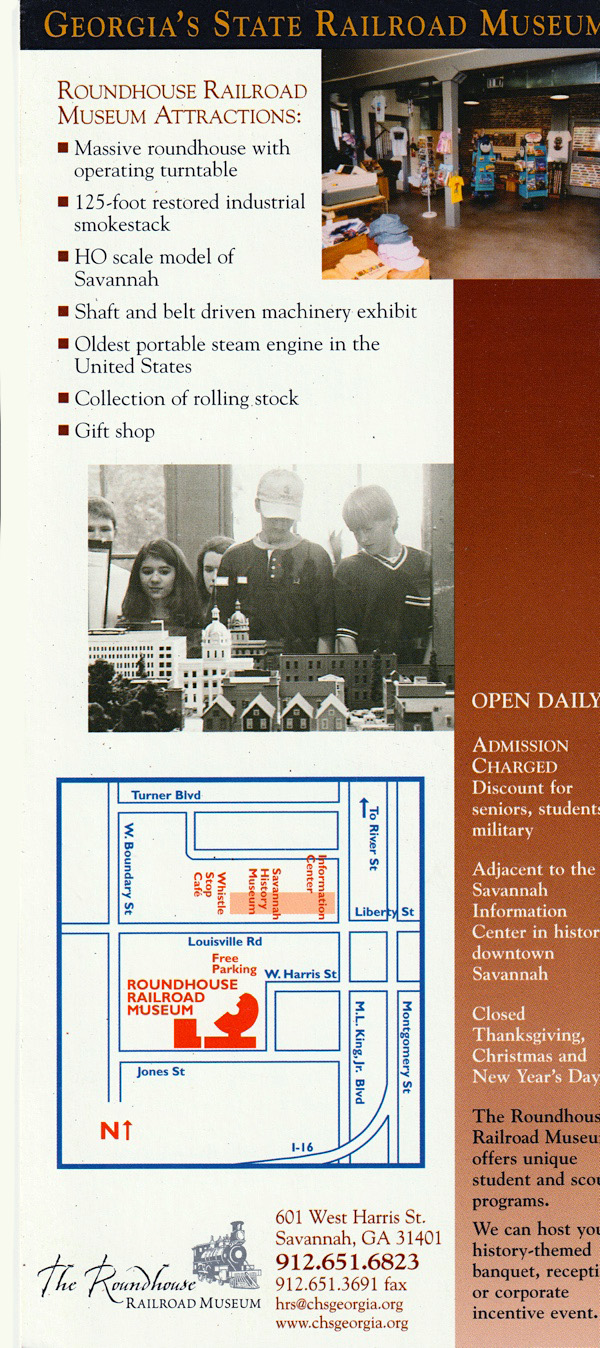
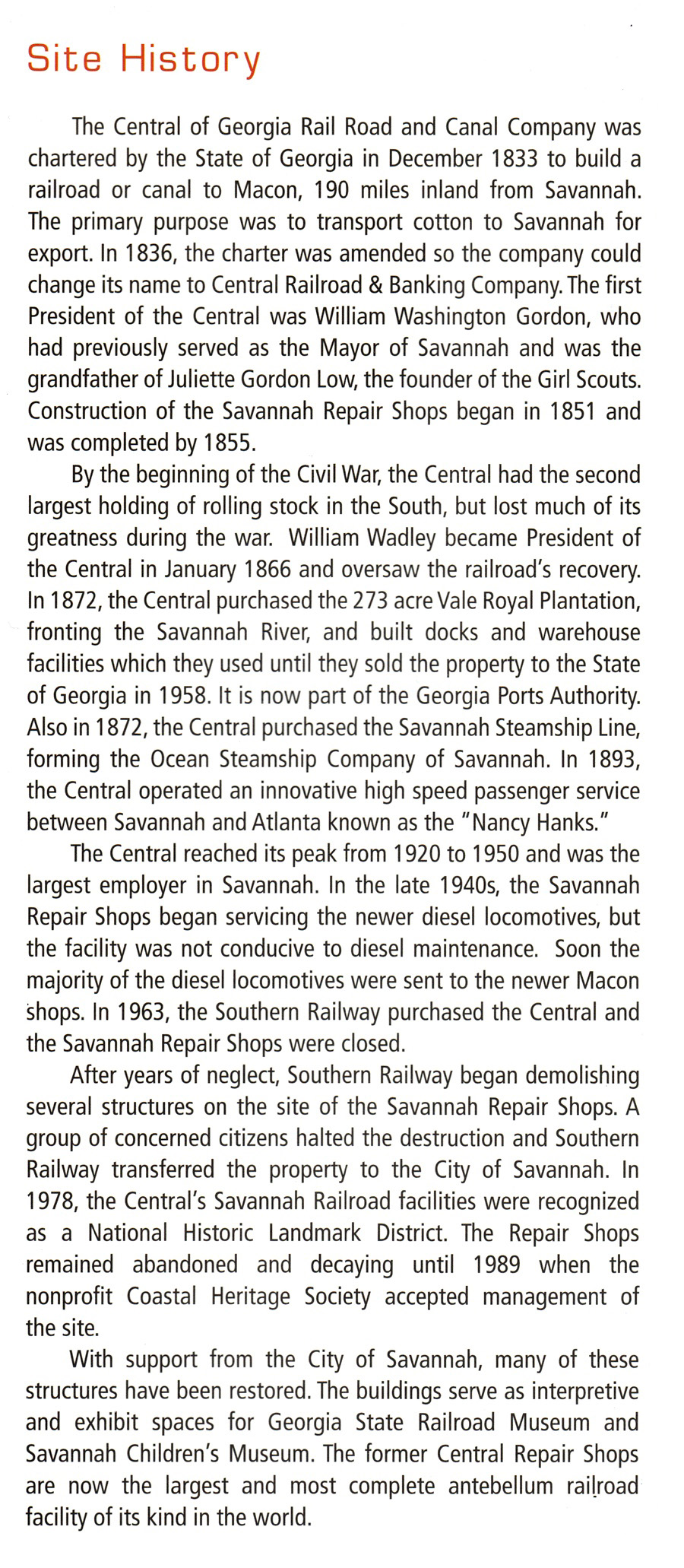
collection

postcard / collection

postcard / collection
 Lagniappe
Lagniappe
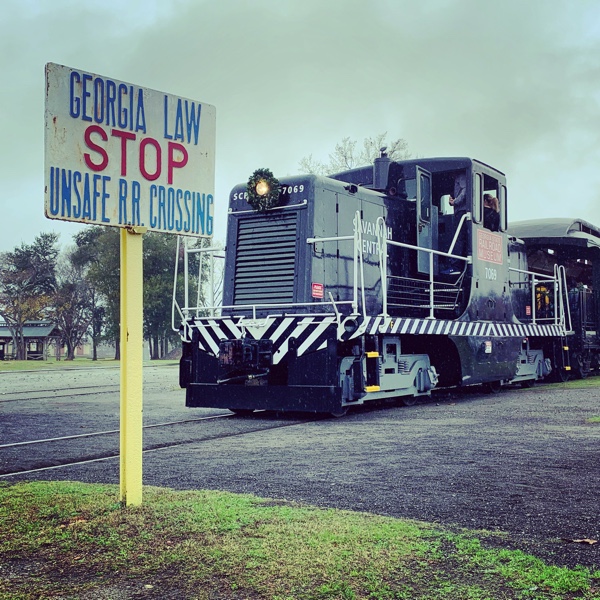
Law Breaker
Savannah, Ga / Dec 2019 / RWH
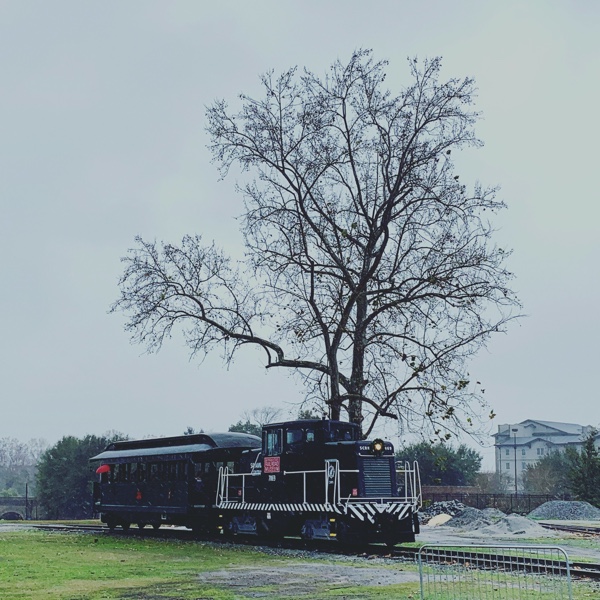
Late Afternoon Outing
Savannah, Ga / Dec 2019 / RWH

Straight Through the Heart
Savannah, Ga / Dec 2019 / RWH
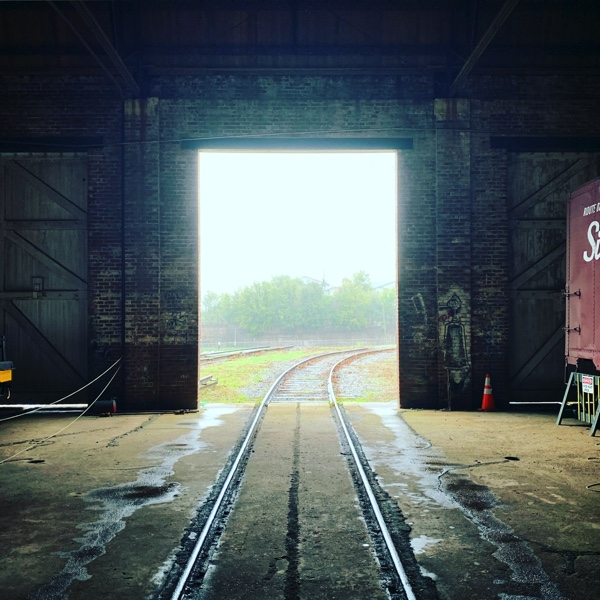
Venture Outward
Savannah, Ga / Dec 2019 / RWH

Her Christmas Dress
Savannah, Ga / Dec 2019 / RWH

Portal to Yesteryear
Savannah, Ga / Dec 2019 / RWH
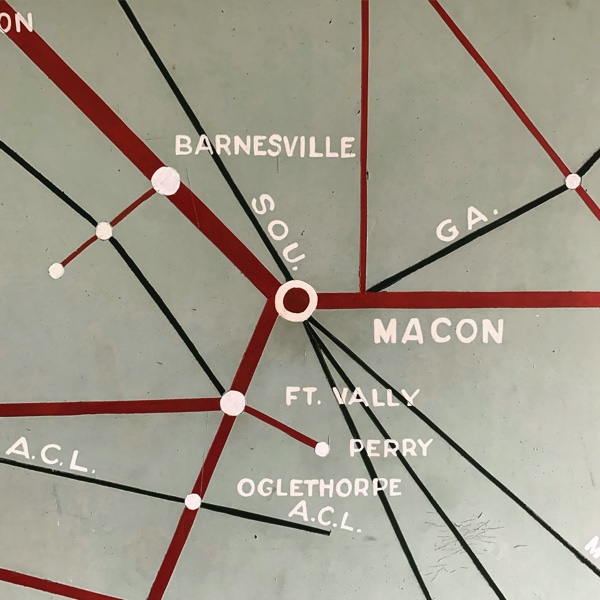
Macon Mecca
Savannah, Ga / Dec 2019 / RWH
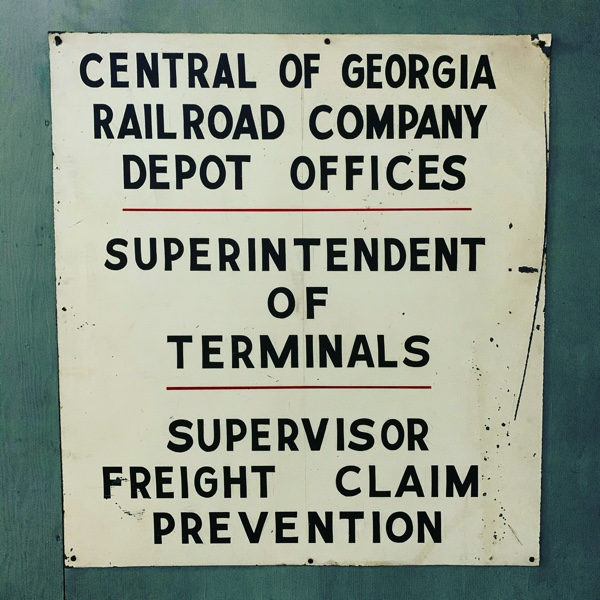
Call the Super
Savannah, Ga / Dec 2019 / RWH
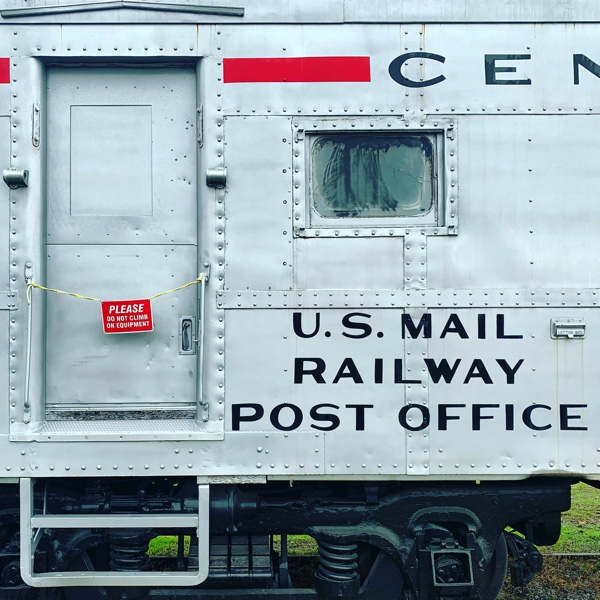
First Class
Savannah, Ga / Dec 2019 / RWH
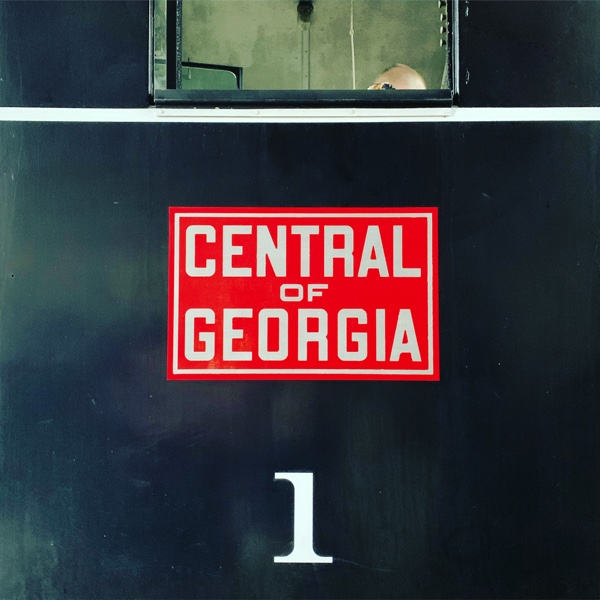
Top of the Roster
Savannah, Ga / Dec 2019 / RWH
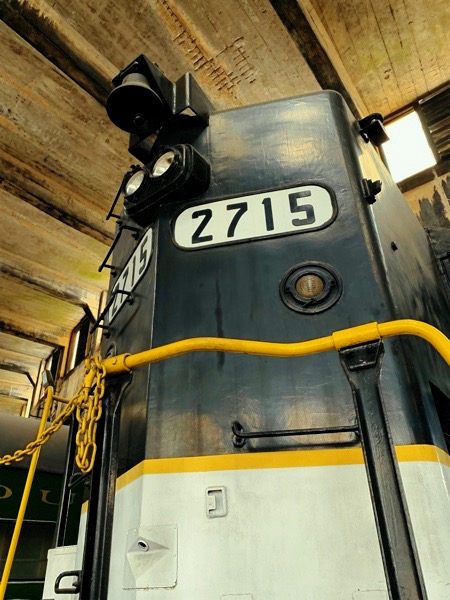
Those Southern Lines
Savannah, Ga / Dec 2019 / RWH
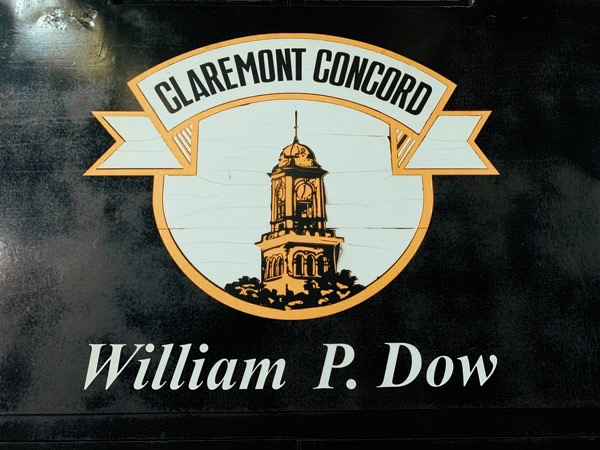
Yankee Down South
Savannah, Ga / Dec 2019 / RWH
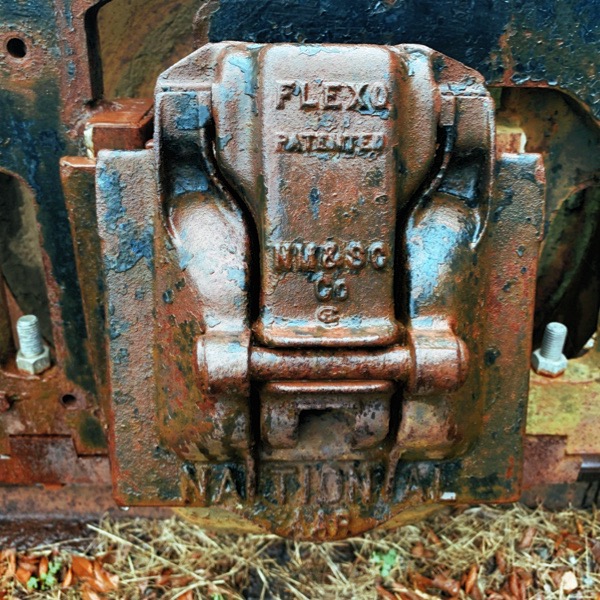
National Flex
Savannah, Ga / Dec 2019 / RWH

Captain's Corner
Savannah, Ga / Dec 2019 / RWH
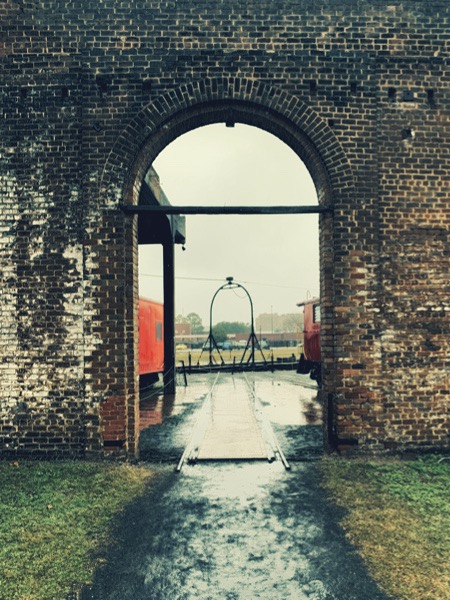
Memory Banks
Savannah, Ga / Dec 2019 / RWH
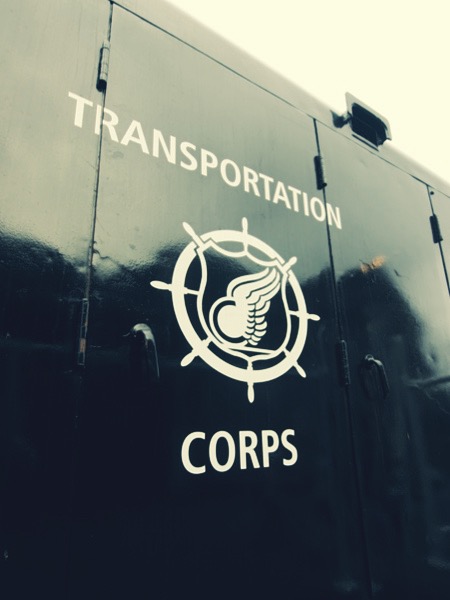
Semper Fideles
Savannah, Ga / Dec 2019 / RWH
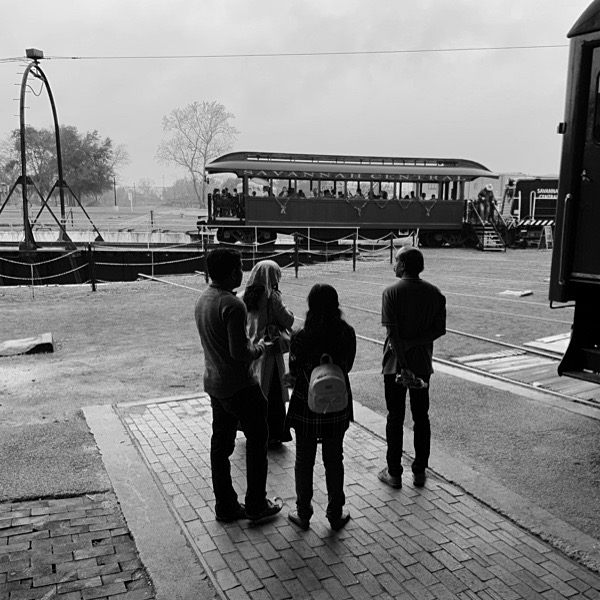
Bystanders
Savannah, Ga / Dec 2019 / RWH
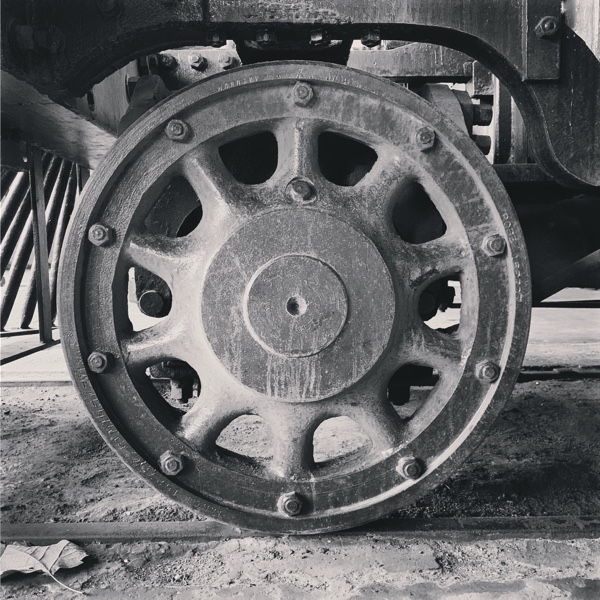
Reinvention
Savannah, Ga / Dec 2019 / RWH




Inky Engines
James McInvale / The Inky Atlas
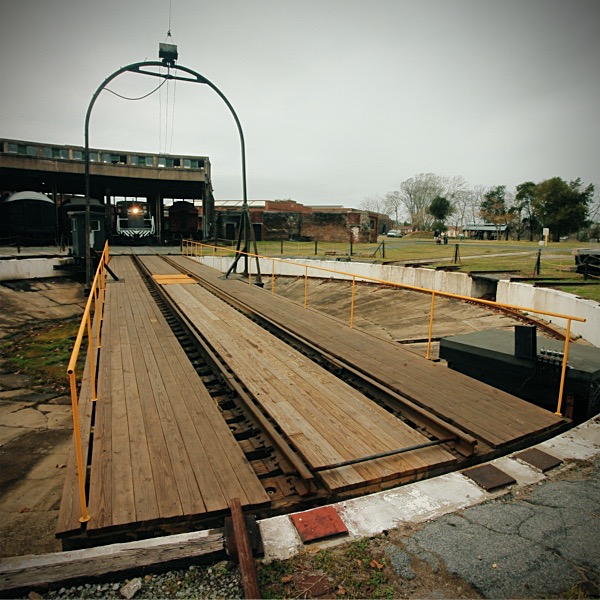
Lined up for Launch
Savannah, Ga / Dec 2019 / RWH

Respirator
Oct 2024 / RWH

Blanket Coverage
Oct 2024 / RWH

Just a Girl and Her Thoughts
Savannah, Ga / Oct 2024 / RWH

Remembering
Oct 2024 / RWH

Signs and Portents
Oct 2024 / RWH

The Calculus of Steaming
Savannah, Ga / Oct 2024 / RWH

Into the Darkness
Savannah, Ga / Oct 2024 / RWH
 Snapshots
Snapshots
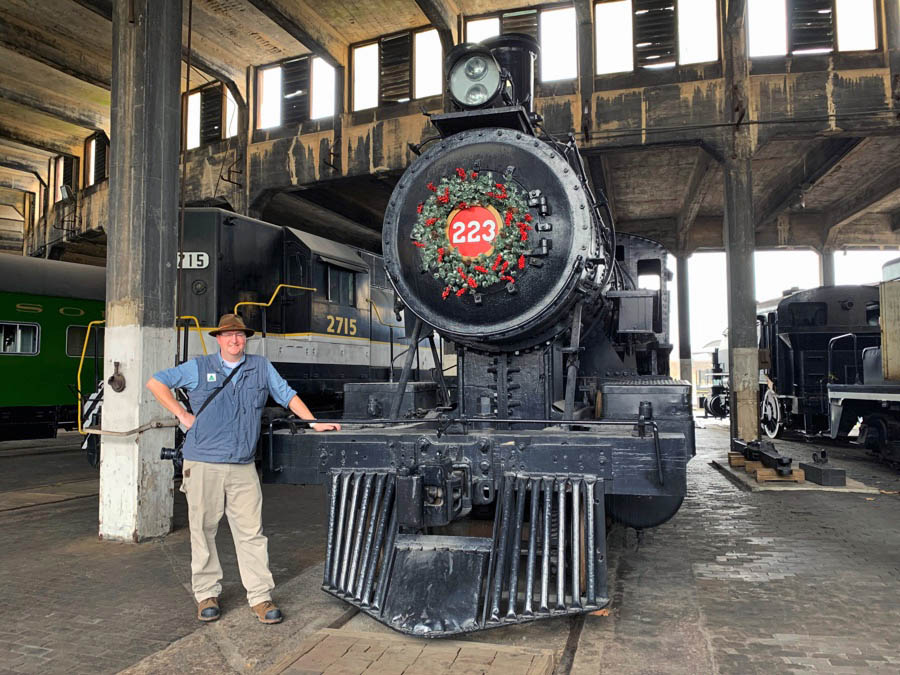
Savannah, Ga / Dec 2019 / RWH

Oct 2024 / RWH
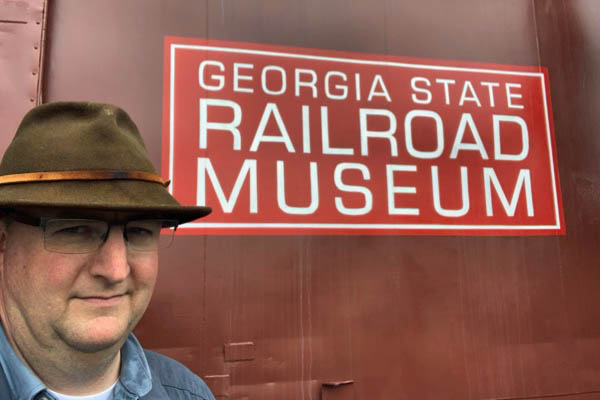
Savannah, Ga / Dec 2019 / RWH

Savannah, Ga / Oct 2024 / RWH

Savannah, Ga / Oct 2024 / DKT

Savannah, Ga / Oct 2024 / RWH
Links / Sources
- Georgia State Railroad Museum website
- Wikipedia article for Georgia State Railroad Museum
- Railroad Picture Archives Georgia State Railroad Museum roster
- Robert Grant's Georgia State Railroad Museum collection
- Forrest Beckum Jr & Albert Langley Jr, Central of Georgia Railway Album (Union Station Publishing, 1986)


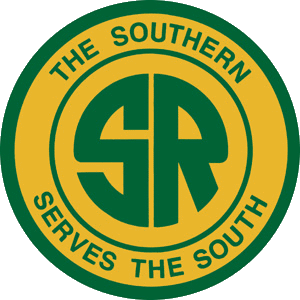
 The Historic Railroad Shops complex is among the finest remaining examples of Victorian railroad architecture and design and is the most intact antebellum railroad repair complex in the country. It was designated a National Historic Landmark by the National Park Service. On-site displays include antique shaft driven machinery, locomotives and railroad stock, model train layouts, an operating turntable, and the oldest portable steam engine in the United States. The Historic Railroad Shops offers a valuable educational experience for students and has also become a popular local tourist attraction.
The Historic Railroad Shops complex is among the finest remaining examples of Victorian railroad architecture and design and is the most intact antebellum railroad repair complex in the country. It was designated a National Historic Landmark by the National Park Service. On-site displays include antique shaft driven machinery, locomotives and railroad stock, model train layouts, an operating turntable, and the oldest portable steam engine in the United States. The Historic Railroad Shops offers a valuable educational experience for students and has also become a popular local tourist attraction.











